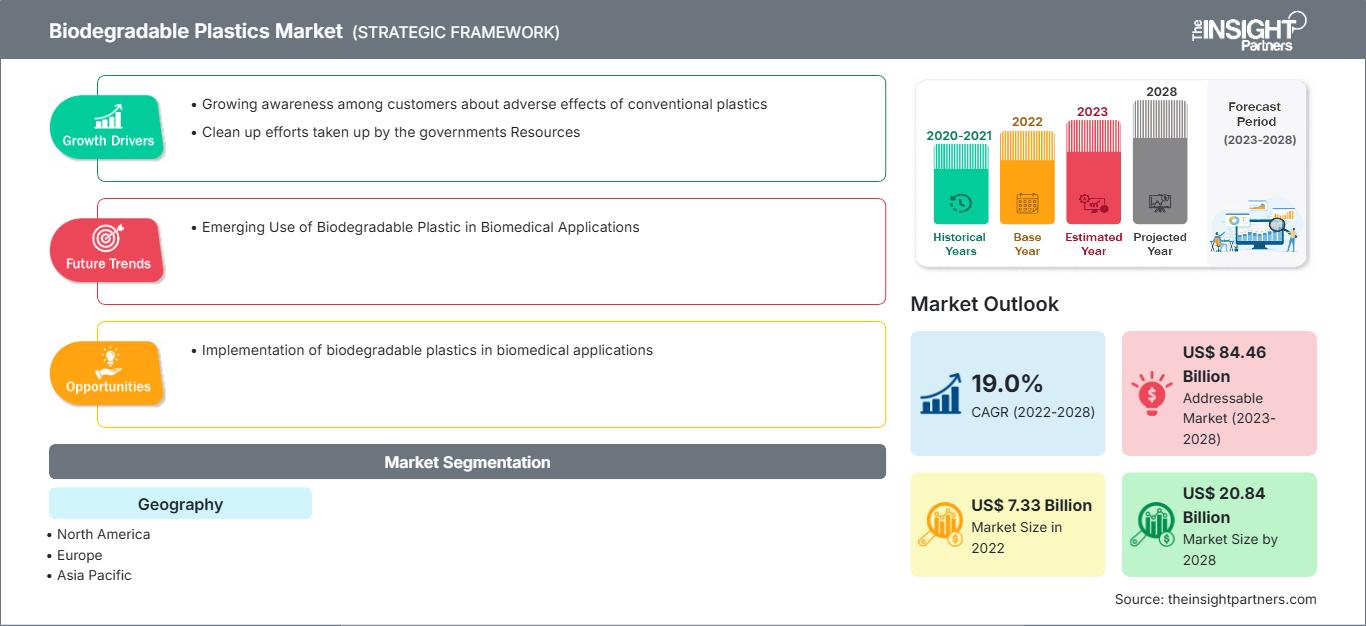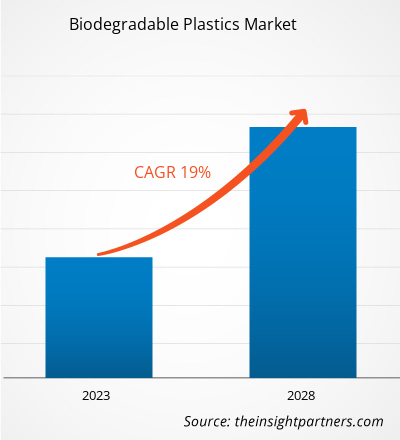[Research Report] The biodegradable plastics market size is expected to grow from US$ 7,331.11 million in 2022 to US$ 20,840.29 million by 2028; it is estimated to record a CAGR of 19.0% from 2022 to 2028.
MARKET ANALYSIS
Biodegradable plastic can be decomposed naturally in the environment by the action of living organisms, usually microbes, into water, carbon dioxide, and biomass. It can be synthesized using renewable raw materials, microorganisms, and petrochemicals. They are designed to mineralize in a controlled waste management environment and also provide an effective and environment-friendly alternative to the synthetic polymers. Government bodies and manufacturers across the globe have taken efforts for improving the efficiency of recycling and upcycling plastic wastage. Growing awareness among customers about adverse effects of conventional plastics is anticipated to boost the product demand.
GROWTH DRIVERS AND CHALLENGES
The customers in developed and developing countries have been educated of the ill effects of conventional plastics on their lifestyle and the environment. As a result, they demand more environmentally friendly products, which leads to a depreciation in the use of crude oil and natural gas, that results in the reduction carbon footprints. . Biodegradable plastic is a surrogate for nearly all conventional plastics used in a diverse range of applications. These plastics offer innovative alternatives with enhanced properties, along with distinctive ability to lessen the emissions as well as provide the same qualities and functionalities as that of conventional plastics. The biodegradable plastics are synthesized using renewable resources as well as fossil raw materials, such as cellulose ester, PLA, PHA, starch derivatives, and copolyesters. Various organizations are engaged in bringing transformation in the handling of plastics, through strategic planning, communication, consumer awareness campaigns, documentary films, education, clean up campaigns, raising business awareness, scientific research, entrepreneurial innovation, legislation, and sustainability. The key aim is to educate the users regarding plastic pollution, thereby encouraging the invention of more sustainable solutions, and empowerment of more people and business organizations to take action to stop plastic pollution. Therefore, the revolution in consumer demand on the basis of environmental awareness, packaging convenience, and sustainable plastic production systems is boosting the biodegradable plastic market growth.
Customize This Report To Suit Your Requirement
You will get customization on any report - free of charge - including parts of this report, or country-level analysis, Excel Data pack, as well as avail great offers and discounts for start-ups & universities
Biodegradable Plastics Market: Strategic Insights

-
Get Top Key Market Trends of this report.This FREE sample will include data analysis, ranging from market trends to estimates and forecasts.
REPORT SEGMENTATION AND SCOPE
The "Global Biodegradable Plastics Market Analysis to 2030" is a specialized and in-depth study with a major focus on the global market trends and growth opportunities. The report aims to provide an overview of the global market with detailed market segmentation by type, end user, and geography. The global biodegradable plastics market has been witnessing high growth over the recent past and is expected to continue this trend during the forecast period. The report provides key statistics on the consumption of biodegradable plastics worldwide along with their demand in major regions and countries. In addition, the report provides the qualitative assessment of various factors affecting the biodegradable plastics market performance in major regions and countries. The report also includes a comprehensive analysis of the leading players in the biodegradable plastics market and their key strategic developments. Several analyses on the market dynamics are also included to help identify the key driving factors, market trends, and lucrative opportunities that would, in turn, aid in identifying the major revenue pockets.
Further, ecosystem analysis and Porter’s five forces analysis provide a 360-degree view of the global biodegradable plastics market, which helps understand the entire supply chain and various factors affecting the market growth.
SEGMENTAL ANALYSIS
The global biodegradable plastics market is segmented on the basis of type, and end user. Based on type, the biodegradable plastics market is segmented as PLA, PHA, starch blends, PBS, PBAT, and others. On the basis of end user, the market is classified as, packaging and bags, agriculture and horticulture, consumer goods, and others. Based on type, the starch blends accounted for a significant share. Starch is a naturally occurring polymer that is found in plants such as corn, rice and potatoes in the form of water-insoluble granules. Starch has been receiving growing attention as raw material for the production of films due to the lack of the availability of the conventional film-forming resins. Polyhydroxyalkanoates (PHA) belongs to the family of naturally occurring polymers. The PHA has found a vital place in the medical applications owing to its biocompatibility. It has a good ultraviolet resistance but resists poorly to acids and bases and is also soluble in chloroform and other chlorinated hydrocarbons. PBS is known to naturally decompose in water and carbon dioxide. PBS is widely used in the manufacturing of packaging films and boxes and also in cosmetic packaging. Based on end user, packaging and bags segment accounted for a major share. The biodegradable plastics have found a vital place in the packaging and bags sector owing to its properties like high tensile strength and convenience of usage as compared to the conventional plastics. Surging demand for environmentally friendly food packaging is shifting the focus of crucial polymer manufacturers and packaging companies to decomposable plastics. The use of sustainable plastics in everyday life has been included in the manufacturing of consumer goods including toys, combs, tool handles and other goods. The PLA and PHA polymers have found widescale applications in production of toys. Italeri, one of the leading Italian toy manufacturing companies, has implemented the use of PHA and PLA plastic for the production of toys.
REGIONAL ANALYSIS
The report provides a detailed overview of the global biodegradable plastics market with respect to five major regions, namely; North America, Europe, Asia-Pacific (APAC), Middle East and Africa (MEA) and South & Central America. Europe accounted for a significant share of the market and valued at more than US$ 2,600 million in 2022. The dominance is attributed to increasing environmental concerns among consumer and rising adoption of biodegradable plastics owing to its eco-friendly nature. Moreover, stringent regulations imposed on single use plastic band coupled with government initiatives towards adoption of recyclable packaging will drive the regional industry size. North America is also expected to witness considerable growth valued at approximately US$ 4,900 million in 2028, attributed to the to increasing awareness among people for environment-friendly products. Growing awareness about global warming and plastic pollution propels consumers to opt for environmentally friendly packaging’s. Asia Pacific is growing considerably with CAGR with more than 20.5%. The rising number of bans on traditional plastics proves to be the primary driver for the growth of this market. Besides, the growing demand for flexible packaging from the consumer goods industry and the adoption of various technological innovations in packaging will boost the regional growth.
INDUSTRY DEVELOPMENTS AND FUTURE OPPORTUNITIES
The report provides a detailed overview of the global biodegradable plastics market with respect to five major regions, namely; North America, Europe, Asia-Pacific (APAC), Middle East and Africa (MEA) and South & Central America.
In 2022, Kaneka announced to invest 15 billion Japanese yen to increase its production capacity for KANEKA Biodegradable Polymer Green Planet in Japan. The investment is aimed to increase the production capacity from 5,000 metric tons to around 20,000 metric tons per year, with operations set to commence in January 2024.
In 2021, South Korea based SK Group, announced to form strategic partnership with local trading company LX International and food firm Daesang to launch a joint venture (JV) for production of PBAT with an investment worth US$ 151.3 million.
Biodegradable Plastics Market Regional InsightsThe regional trends and factors influencing the Biodegradable Plastics Market throughout the forecast period have been thoroughly explained by the analysts at The Insight Partners. This section also discusses Biodegradable Plastics Market segments and geography across North America, Europe, Asia Pacific, Middle East and Africa, and South and Central America.
Biodegradable Plastics Market Report Scope
| Report Attribute | Details |
|---|---|
| Market size in 2022 | US$ 7.33 Billion |
| Market Size by 2028 | US$ 20.84 Billion |
| Global CAGR (2022 - 2028) | 19.0% |
| Historical Data | 2020-2021 |
| Forecast period | 2023-2028 |
| Regions and Countries Covered |
North America
|
| Market leaders and key company profiles |
|
Biodegradable Plastics Market Players Density: Understanding Its Impact on Business Dynamics
The Biodegradable Plastics Market is growing rapidly, driven by increasing end-user demand due to factors such as evolving consumer preferences, technological advancements, and greater awareness of the product's benefits. As demand rises, businesses are expanding their offerings, innovating to meet consumer needs, and capitalizing on emerging trends, which further fuels market growth.

- Get the Biodegradable Plastics Market top key players overview
IMPACT OF COVID/IMPACT OF GEOPOLITICAL SCENARIO/IMPACT OF RECESSION
The report provides a detailed overview of the global biodegradable plastics market with respect to five major regions, namely; North America, Europe, Asia-Pacific (APAC), Middle East and Africa (MEA) and South & Central America. Industries such as packaging and bags, agriculture and horticulture, and consumer goods, and automotive have been the major consumers of biodegradable plastics. In 2020, these industries had to slow down their operations due to disruptions in the value chain caused by the shutdown of national and international boundaries. Moreover, lockdowns imposed by different countries hampered the ability of industries to maintain inventory levels in the same year. The pandemic also wreaked havoc on the automotive and consumer goods industry. The shortage of manpower resulted in the deceleration of biodegradable plastics production and distribution operations. Additionally, government restrictions and other COVID-19 precautions reduced the production capacities of biodegradable plastics manufacturers in the value chain. In 2021, the global marketplace began recovering from the losses incurred in 2020 as governments of different countries announced relaxations in social restrictions. Further, rising government bans for single use plastics, and expanding production capacities in the agriculture and food & beverage packaging industry in different regions of the world resulted in a rise in demand for biodegradable plastics in 2021.
COMPETITIVE LANDSCAPE AND KEY COMPANIES
Some of the key players operating in the biodegradable plastics market include, BASF SE, FKuR Kunststoff GmbH, Green Dot Bioplastics Inc, Novamont SpA, Kingfa Science and Technology Co Ltd, NatureWorks LLC, Mitsubishi Chemical Holdings Corp, Plantic Technologies Ltd, TotalEnergies Corbion BV, and API SpA, among others.
Frequently Asked Questions
What are the key drivers for the growth of the global biodegradable plastics market?
Based on type, why does the starch blends segment have the largest revenue share?
What are the opportunities for biodegradable plastics in the global market?
Can you list some of the major players operating in the global biodegradable plastics market?
What is the largest region of the global biodegradable plastics market?
Based on the end-user, which is the fastest-growing segment in the biodegradable plastics market?
- Historical Analysis (2 Years), Base Year, Forecast (7 Years) with CAGR
- PEST and SWOT Analysis
- Market Size Value / Volume - Global, Regional, Country
- Industry and Competitive Landscape
- Excel Dataset
Recent Reports
Related Reports
Testimonials
Reason to Buy
- Informed Decision-Making
- Understanding Market Dynamics
- Competitive Analysis
- Identifying Emerging Markets
- Customer Insights
- Market Forecasts
- Risk Mitigation
- Boosting Operational Efficiency
- Strategic Planning
- Investment Justification
- Tracking Industry Innovations
- Aligning with Regulatory Trends





















 Get Free Sample For
Get Free Sample For